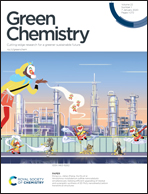Carotenoids, chlorophylls and phycocyanin from Spirulina: supercritical CO2 and water extraction methods for added value products cascade†
Abstract
In the last decade, the cyanobacterium Spirulina has gained a high commercial interest as a food supplement, mainly due to its high protein content as well as high amounts of pigments, such as carotenoids, chlorophylls and phycocyanins. In particular, phycocyanin has been widely considered as a precious food-dye because of its protein-based structure and the rare intense-blue color. Different strategies were developed for the isolation and purification of phycocyanin. The main drawback of such processes is that carotenoids and chlorophylls are generally wasted together with the residual biomass. In this study, a different approach is proposed, suggesting an integrated pigment extraction chain. The body of the strategy involves two consecutive steps of the supercritical-CO2 extraction of carotenoids and chlorophylls, before phycocianin extraction. The total carotenoid, chlorophyll a and chlorophyll b contents in the extracts were equal to 3.5 ± 0.2 mg g−1, 5.7 ± 0.2 mg g−1 and 3.4 ± 0.3 mg g−1, respectively (by dry Spirulina weight). The biomass residue, exhausted in terms of carotenoids and chlorophylls, was then extracted in water to yield phycocyanin. Consecutive steps were developed in order to ehance the phycocyanin purity, including electrocoagulation, dialysis and protein salting-out. These processes yielded 250 mg g−1 of phycocyanin (by dry Spirulina weight). A potentially scalable strategy to obtain the blue pigment with high purity (A620/A280 = 2.2) was developed. The practical application of the extracted blue phycocyanin pigment as a cotton-based tissue colorant was also experimented.



 Please wait while we load your content...
Please wait while we load your content...